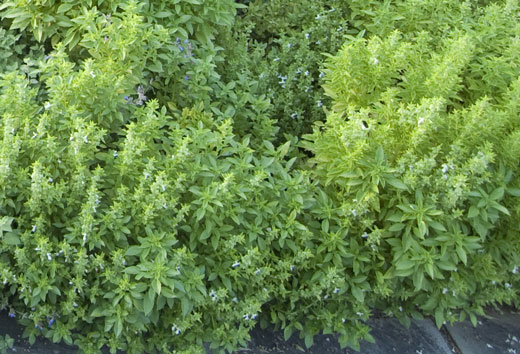Thymus

The common name for Thymus, a genus of aromatic herbs or shrubby plants of the Mint Family, long cultivated and valued as both ornamentals and sweet herbs. They have small lavender or pink flowers and are planted in the rock garden and the border for ornament, or in the herb garden, to be used for seasoning. They grow easily and are easily increased from cuttings or seed.
Growing the Herb Thyme
To achieve optimum results, plant the seed indoors in early spring. Thyme is very hardy and will grow under most conditions. It prefers full sun and a soil that is light and sandy, or loamy. Thyme requires minimal fertilization unless the soil quality is of extremely poor quality, or when grown via the hydroponic method.
Thyme propagates easily from tip cuttings or crown division. Since it grows slowly, especially early in it’s life, weed-control is essential. Mulching with straw is helpful.
Thyme is harvested in mid-summer, just prior to flowering. Secondary growth will occur for the balance of the year, and this growth should be left to grow, or winter hardiness will be sacrificed.
Growing Cultures
Outdoors, in containers, and hydroponic cultures.
Plant Height
Thyme plants grow to a height of 12 to 18 inches (30 – 45cm).
Plant Spacing
Thyme plants should be spaced 18 to 24 inches (45 – 60cm) apart.
Preferred pH Range
Thyme will grow in a pH range between 6.5 (neutral) and 8.5 (alkaline) with a preferred pH range between 6.5 and 7.0.
Propagation
Sow thyme seed indoors in sunny location or under plant grow lights six weeks before last frost. Thyme propagates well through stem cuttings.
Seed Germination Period
Thyme seeds will germinate in approximately 8 to 20 days.
Number of Seeds per Gram
There are between approximately 3,300 and 4,000 Thyme seeds per gram.
Soil Requirements
Thyme grows well in a light, well-draining soil, poor to fertile.
Alternative Growing Media
Soilless potting mixes (Pro-Mix, Sunshine Mix, etc.), perlite, vermiculite, coco peat, rockwool, and Oasis cubes.
Time From Seed to Saleable Plant
Sow in plugs 12 to 14 weeks before sale. Seeds to finished plugs, 6 to 8 weeks; plugs to saleable plants, 4 to 6 weeks.
Sun & Lighting Requirements
Thyme grown outdoors prefers full sun.
Thyme will grow indoors satisfactorily under standard fluorescent lamps, and exceptionally well under high output T5 fluorescent, compact fluorescent, or high intensity discharge (metal halide or high pressure sodium) plant growing lights. Keep standard fluorescent lamps between 2 and 4 inches from the tops of the plants, high output and compact fluorescents approximately one foot above the plants, and HID lights between 2 and 4 feet above the plants, depending on wattage.
Have an oscillating fan gently stir seedlings for at least 2 hours per day to stimulate shorter, sturdier, and more natural plant habit.
USDA Hardiness
Perennial. Zones 4a to 8b.
Water Requirements
Average water needs. Water on a regular schedule. Allow soil to go completely dry between watering, then soak thoroughly.
Potential Plant Pests and Diseases
Thyme can be susceptible to whitefly and spider mites, but has minimal disease issues.
Companion Planting
Thyme is an ideal companion for cabbage and broccoli by detering white fly infestations.
Special Notes
Drought resistant and ideal for xeriscaping. Suitable for containers and indoor cultivation. Attracts butterflies, birds, or bees.
Buy Thyme Seeds by Heirloom English Thyme Seeds
A wonderful herb which no cook should be without! Endless culinary possibilities, and an aromatic, attractive plant.
Organic Heirloom English Thyme Seeds
Organic version of above.
